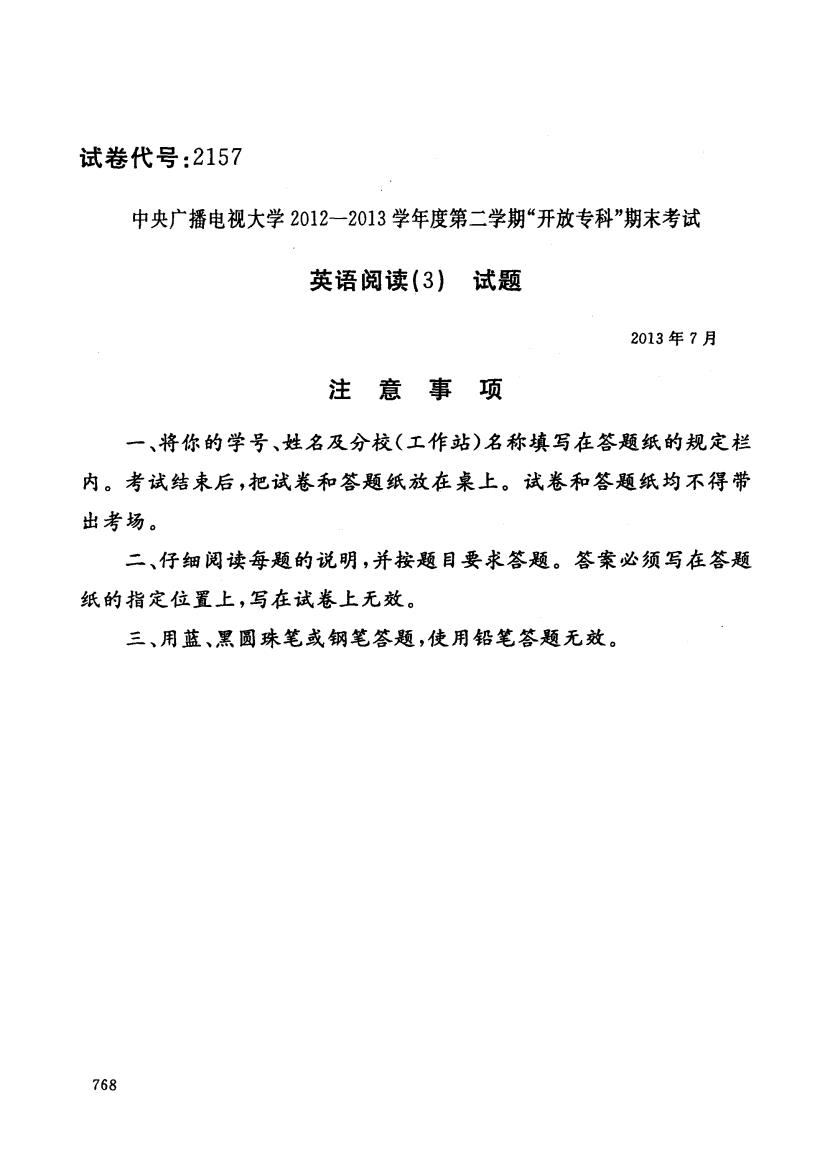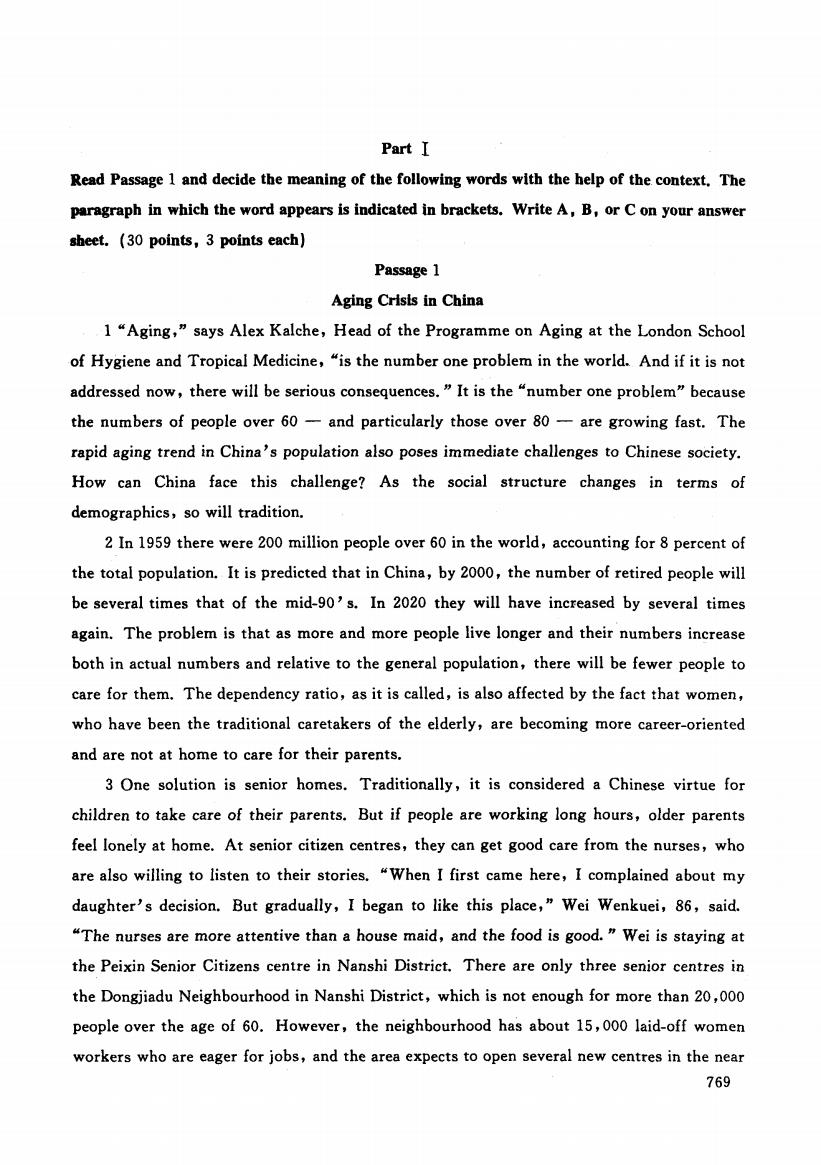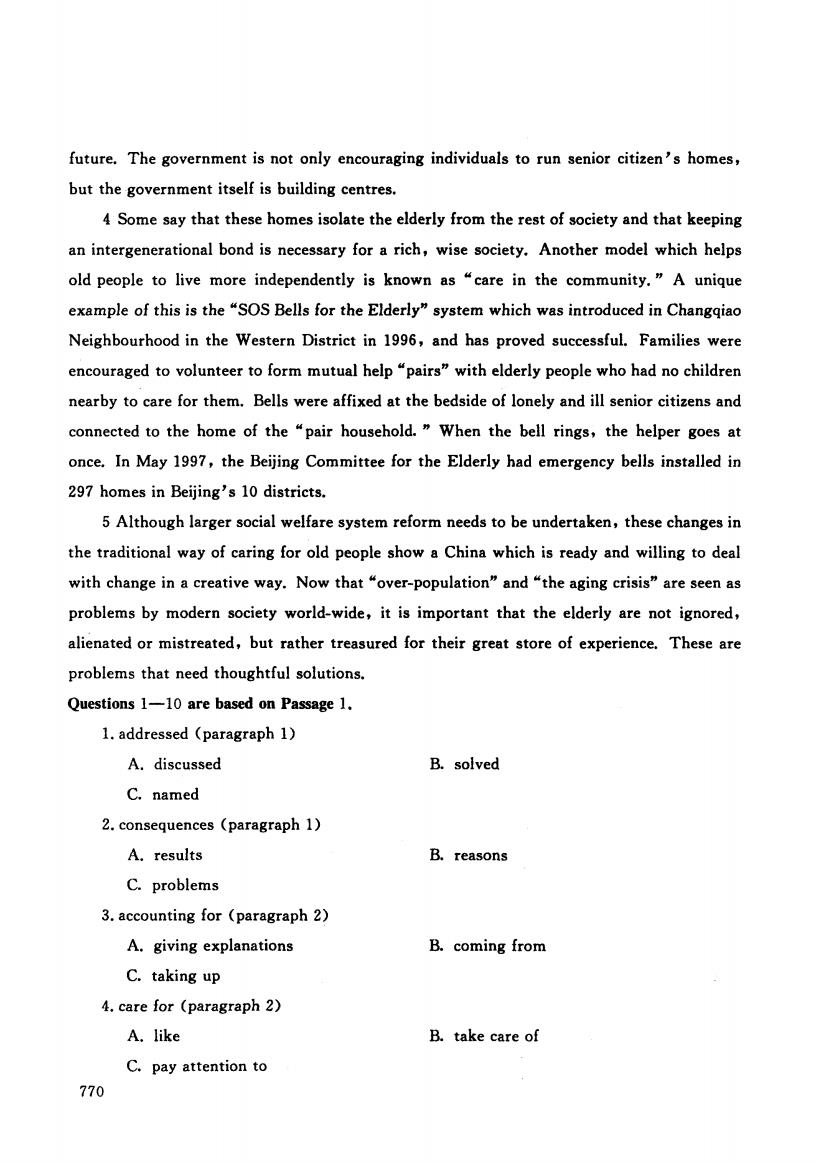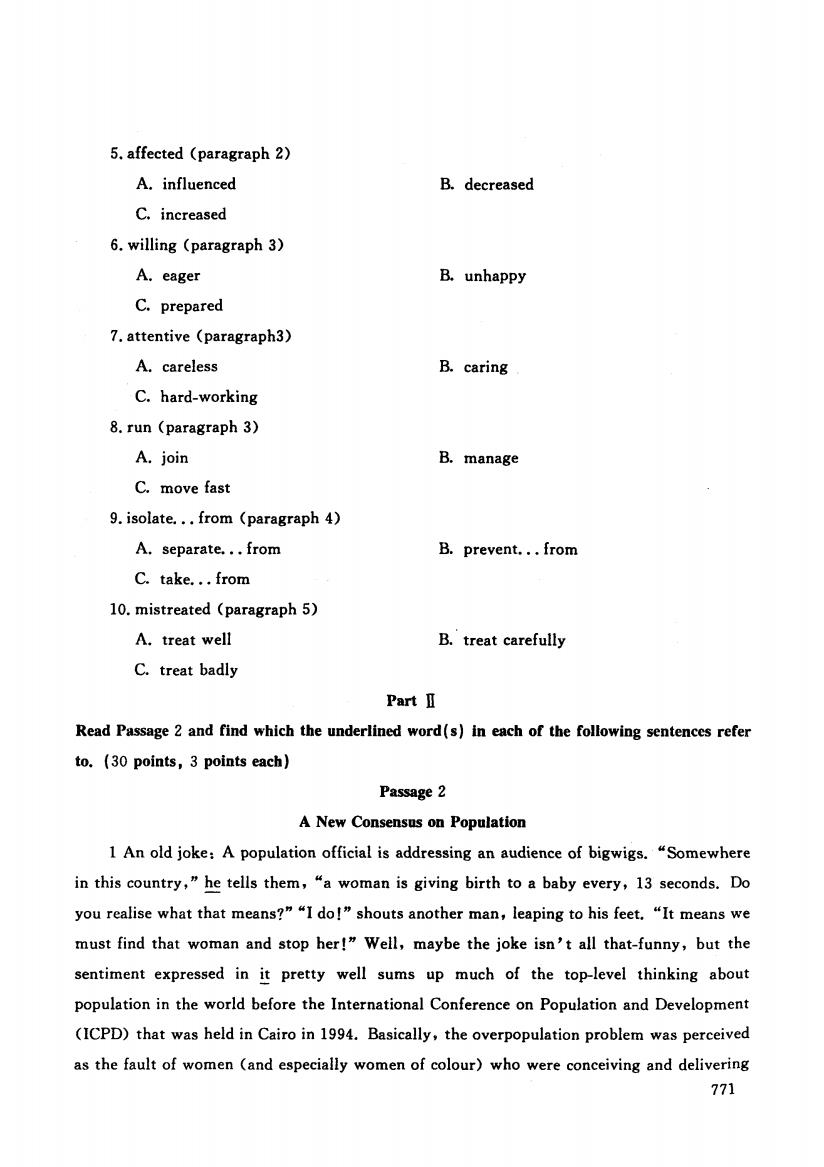
试卷代号:2157 中央广播电视大学2012一2013学年度第二学期“开放专科”期末考试 英语阅读(3)试题 2013年7月 注意事项 一、将你的学号、姓名及分校(工作站)名称填写在答题纸的规定栏 内。考试结束后,把试卷和答题纸放在桌上。试卷和答题纸均不得带 出考场。 二、仔细阅读每题的说明,并按题目要求答题。答案必须写在答题 纸的指定位置上,写在试卷上无效。 三、用蓝、黑圆珠笔或钢笔答题,使用铅笔答题无效。 768
试卷代号 中央广播电视大学 2 0 3学年度第二学期"开放专科"期末考试 英语阅读 试题 2013 年7 注意事项 一、将你的学号、姓名及分校〈工作站)名称填写在答题纸的规定栏 内。考试结束后,把试卷和答题纸放在桌上。试卷和答题纸均不得带 出考场。 二、仔细阅读每题的说明,并按题目要求答题。答案必须写在答题 纸的指定位置上,写在试卷上无效。 三、用蓝、黑圆珠笔或钢笔答题,使用铅笔答题无效。 768

Part I Read Passage 1 and decide the meaning of the following words with the help of the context.The paragraph in which the word appears is indicated in brackets.Write A,B,or C on your answer sheet.(30 points,3 points each) Passage 1 Aging Crists in China 1 "Aging,says Alex Kalche,Head of the Programme on Aging at the London School of Hygiene and Tropical Medicine,"is the number one problem in the world.And if it is not addressed now,there will be serious consequences."It is the "number one problem"because the numbers of people over 60-and particularly those over 80-are growing fast.The rapid aging trend in China's population also poses immediate challenges to Chinese society. How can China face this challenge?As the social structure changes in terms of demographics,so will tradition. 2 In 1959 there were 200 million people over 60 in the world,accounting for 8 percent of the total population.It is predicted that in China,by 2000,the number of retired people will be several times that of the mid-90's.In 2020 they will have increased by several times again.The problem is that as more and more people live longer and their numbers increase both in actual numbers and relative to the general population,there will be fewer people to care for them.The dependency ratio,as it is called,is also affected by the fact that women, who have been the traditional caretakers of the elderly,are becoming more career-oriented and are not at home to care for their parents. 3 One solution is senior homes.Traditionally,it is considered a Chinese virtue for children to take care of their parents.But if people are working long hours,older parents feel lonely at home.At senior citizen centres,they can get good care from the nurses,who are also willing to listen to their stories."When I first came here,I complained about my daughter's decision.But gradually,I began to like this place,"Wei Wenkuei,86,said. "The nurses are more attentive than a house maid,and the food is good."Wei is staying at the Peixin Senior Citizens centre in Nanshi District.There are only three senior centres in the Dongjiadu Neighbourhood in Nanshi District,which is not enough for more than 20,000 people over the age of 60.However,the neighbourhood has about 15,000 laid-off women workers who are eager for jobs,and the area expects to open several new centres in the near 769
Part I ReadP 姐ge 1 and 民ide the meaning of the following words with the help of the context. The par raph in which the word appears is indicated in brackets. Write A. B. or C on your answer 曲目 (30 points. 3 points each) Passage 1 Aging Crisis in China 1 "Aging," says Alex Kalche , Head of the Programme on Aging at the London School of Hygiene and Tropical Medicine , "is the number one problem in the world. And if it is not addressed now , there will be serious consequences. " It is the "number one problem" because the numbers of people over 60 - and particularly those over 80 - are growing fast. The rapid aging trend in China's population also poses immediate challenges to Chinese society. How can China face this challenge? As the social structure changes in terms of demographics. so will tradition. 2 In 1959 there were 200 million people over 60 in the world , accounting for 8 percent of the total population. It is predicted that in China , by 2000. the number of retired people will be several times that of the mid-90' s. In 2020 they will have increased by several times again. The problem is that as more and more people live longer and their numbers increase both in actual numbers and relative to the general population , there will be fewer people to care for them. The dependency ratio. as it is called , is also affected by the fact that women , who have been the traditional caretakers of the elderly, are becoming more career-oriented and are not at home to care for their parents. 3 One solution is senior homes. Traditionally , it is considered a Chinese virtue for children to take care of their parents. But if people are working long hours, older parents feellonely at home. At senior citizen centres, they can get good care from the nurses, who are also willing to listen to their stories. "When I first came here , I complained about my daughter's decision. But gradually. I began to like this place ," Wei Wenkuei. 86 , said. "The nurses are more attentive than a house maid , and the food is good. " Wei is staying at the Peixin Senior Citizens centre in Nanshi District. There are only three senior centres in the Dongjiadu Neighbourhood in Nanshi District, which is not enough for more than 20 ,000 people over the age of 60. However, the neighbourhood has about 15 ,000 laid-off women workers who are eager for jobs, and the area expects to open several new centres in the near 769

future.The government is not only encouraging individuals to run senior citizen's homes, but the government itself is building centres. 4 Some say that these homes isolate the elderly from the rest of society and that keeping an intergenerational bond is necessary for a rich,wise society.Another model which helps old people to live more independently is known as "care in the community."A unique example of this is the "SOS Bells for the Elderly"system which was introduced in Changqiao Neighbourhood in the Western District in 1996,and has proved successful.Families were encouraged to volunteer to form mutual help"pairs"with elderly people who had no children nearby to care for them.Bells were affixed at the bedside of lonely and ill senior citizens and connected to the home of the "pair household."When the bell rings,the helper goes at once.In May 1997,the Beijing Committee for the Elderly had emergency bells installed in 297 homes in Beijing's 10 districts. 5 Although larger social welfare system reform needs to be undertaken,these changes in the traditional way of caring for old people show a China which is ready and willing to deal with change in a creative way..Now that“over-population”and“the aging crisis”are seen as problems by modern society world-wide,it is important that the elderly are not ignored, alienated or mistreated,but rather treasured for their great store of experience.These are problems that need thoughtful solutions. Questions 1-10 are based on Passage 1. 1.addressed(paragraph 1) A.discussed B.solved C.named 2.consequences (paragraph 1) A.results B.reasons C.problems 3.accounting for (paragraph 2) A.giving explanations B.coming from C.taking up 4.care for (paragraph 2) A.like B.take care of C.pay attention to 770
B. solved future. The government is not only encouraging individuals to run senior citizen's homes, but thegovernment itself is building centres. 4 Some say that these homes isolate the elderly from the rest of society and that keeping an intergenerational bond is necessary for a rich , wise society. Another model which helps old people to live more independently is known as "care in the community." A unique example of this is the "sos Bells for the Elderly" system which was introduced in Changqiao Neighbourhood in the Western District in 1996 , and has proved successful. Families were encouraged to volunteer to form mutual help "pairs" with elderly people who had no children nearby to care for them. Bells were affixed at the bedside of lonely and ill senior citizens and connected to the home of the "pair household. " When the bell rings, the helper goes at once. In May 1997 , the Beijing Committee for the Elderly had emergency bells installed in 297 homes in Beijing's 10 districts. 5 Although larger social welfare system reform needs to be undertaken , these changes in the traditional way of caring for old people show a China which is ready and willing to deal with change in a creative way. Now that "over-population" and "the aging crisis" are seen as problems by modern society world-wide , it is important that the elderly are not ignored , alienated or mistreated , but rather treasured for their great store of experience. These are problems that need thoughtful solutions. Questions 一10 are based on Passage 1. 1. addressed (paragraph 1) A. discussed C. named 2. consequences (paragraph 1) A. results C. problems 3. accounting for (paragraph 2) A. giving explanations C. taking up 4. care for (paragraph 2) A. like C. pay attention to 770 B. reasons B. coming from B. take care of

5,affected (paragraph 2) A.influenced B.decreased C.increased 6.willing (paragraph 3) A.eager B.unhappy C.prepared 7.attentive (paragraph3) A.careless B.caring C.hard-working 8.run (paragraph 3) A.join B.manage C.move fast 9.isolate...from (paragraph 4) A.separate...from B.prevent...from C.take...from 10.mistreated (paragraph 5) A.treat well B.treat carefully C.treat badly Part I Read Passage 2 and find which the underlined word(s)in each of the following sentences refer to.(30 points,3 points each) Passage 2 A New Consensus on Population 1 An old joke:A population official is addressing an audience of bigwigs."Somewhere in this country,"he tells them,"a woman is giving birth to a baby every,13 seconds.Do you realise what that means?”“Idol”shouts another man,leaping to his feet.“It means we must find that woman and stop her!"Well,maybe the joke isn't all that-funny,but the sentiment expressed in it pretty well sums up much of the top-level thinking about population in the world before the International Conference on Population and Development (ICPD)that was held in Cairo in 1994.Basically,the overpopulation problem was perceived as the fault of women (and especially women of colour)who were conceiving and delivering 771
5. affected (paragraph 2) A. influenced C. increased 6. willing (paragraph 3) A. eager C. prepared 7. attentive (paragraph3) A. careless C. hard-working 8. run (paragraph 3) A. join C. move fast 9. isolate. • • from (paragraph 4) A. separate... from C. take... from 10. mistreated (paragraph 5) A. treat well C. treat badly B. decreased B. unhappy B. caring B. manage B. prevent... from B. treat carefully Part II Read Passage 2 and find which the underlined word (s) 回ch of the following sentences refer to. (30 points. 3 points 回ch) 2 A New Consensus on Population 1 An old joke: A population official is addressing an audience of bigwigs. "Somewhere in this country ," he tells them , "a woman is giving birth to a baby every , 13 seconds. Do you realise what that means?" "I do!" shouts another man , leaping to his feet. "It means we must find that woman and stop hed" Well, maybe the joke isn't all that-funny , but the sentiment expressed in i! pretty well sums up much of the top-level thinking about population in the world before the International Conference on Population and Development (lCPD) that was held in Cairo in 1994. Basically, the overpopulation problem was perceived as the fault of women (and especially women of colour) who were conceiving and delivering 771

so many babies-especially in the patriarchal,tradition-based societies of the developing world,where women often had no career open to them except motherhood. 2 The perceived solution?Pushing contraception on women,in some cases abortion, even forced sterilization-whatever it took to reduce women's fertility rates.In some parts of the world,such strategies were yielding dramatic results,at least in terms of meeting numerical targets for reduction of growth rates.But they were also causing revulsion because of their trampling on human rights and human dignity-and also because of their underlying sexism. 3 By the time the international community gathered in Cairo in 1994 to discuss the issue of population and development-similar conferences had been held in 1974 and 1984-it was clear that an entirely different approach was needed. 4 Creating a New Consensus on Population by Jyoti Shankar Singh Earthcan Publications,UK,1998)is the story of how that 180-degree turn was negotiated.As a primary-source history of this momentous achievement,this book is unique.For Singh was no mere observer of the process but,as Executive Co-ordinator of the conference,one of its most strategically placed facilitators.And he lays out the process of reaching the new consensus,step by step,in meticulous detail. 5 What was the new consensus?For one thing,it was agreed that population efforts had to be broadened to cover more than contraception-that raising the "contraceptive prevalence rate"number could not be the only measure of success.Indeed,all such numerical targets and quotas were to be de-emphasized,under the consensus,coercion was to be eliminated, and greater emphasis was to be placed on individual and societal rights and responsibilities and gender equality and empowerment.What's more,it was agreed that family planning (contraception)services should be incorporated into a broader definition of reproductive health activities (including the treatment and prevention of sexually transmitted diseases). 6 As reported by the news media at the time,the Cairo conference seemed full of harsh words stemming largely from the Vatican's opposition to any mention of abortion or of sexual or reproductive rights.But from this history it emerges as a triumph of international policy making. 7 Of course,it is still too early to judge the effectiveness or longevity of the Cairo consensus.The UN General Assembly is gearing up for a formal five-year review in 1999, 772
so many babies - especially in the patriarchal , tradition-based societies of the developing world , where women often had no career open to them except motherhood. 2 The perceived solution? Pushing contraception on women, in some cases abortion , even forced sterilization-whatever it took to reduce women' s fertility rates. In some parts of the world ,such strategies were yielding dramatic results, at least in terms of meeting numerical targets for reduction of growth rates. But they were also causing revulsion because of their trampling on human rights and human dignity-and also because of their underlying sexIsm. 3 By the time the international community gathered in Cairo in 1994 to discuss the issue of population and development-similar conferences had been held in 1974 and 1984一it was clear that an entirely different approach was needed. 4 Creating a New Consensus on Population by ]yoti Shankar Singh (Earthcan Publications, UK , 1998) is the story of how that 180-degree turn was negotiated. As a primary-source history of this momentous achievement, this book is unique. For Singh was no mere observer of the process but , as Executive Co-ordinator of the conference , one of its most strategically placed facilitators. And he lays out the process of reaching the new consensus, step by step , in meticulous detail. 5 What was the new consensus? For one thing , it was agreed that population efforts had to be broadened to cover more than contraception - that raising the "contraceptive prevalence rate" number could not be the only measure of success. Indeed , all such numerical targets and quotas were to be de-emphasized , under the consensus, coercion was to be eliminated , and greater emphasis was to be placed on individual and societal rights and responsibilities and gender equality and empowerment. What's more , it was agreed that family planning (contraception) services should be incorporated into a broader definition of reproductive health activities <including the treatment and prevention of sexually transmitted diseases). 6 As reported by the news media at the time , the Cairo conference seemed full of harsh words stemming largely from the Vatican' s opposition to any mention of abortion or of sexual or reproductive rights. But from this history it emerges as a triumph of international policy making. 7 Of course , it is still too early to judge the effectiveness or longevity of the Cairo consensus. The UN General Assembly is gearing up for a formal five-year review in 1999 , 772